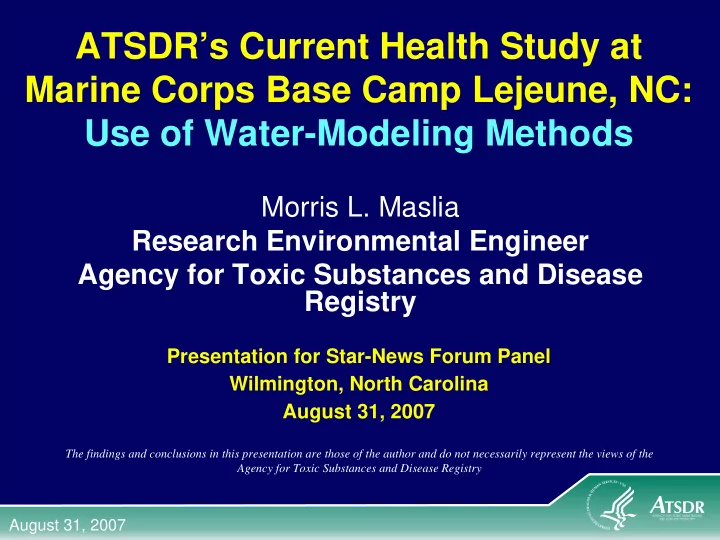

ATSDR’s Current Health Study at Marine Corps Base Camp Lejeune, NC: Use of Water-Modeling Methods Morris L. Maslia Research Environmental Engineer Agency for Toxic Substances and Disease Registry Presentation for Star-News Forum Panel Wilmington, North Carolina August 31, 2007 The findings and conclusions in this presentation are those of the author and do not necessarily represent the views of the Agency for Toxic Substances and Disease Registry August 31, 2007
Co-authors and co-investigators (listed in alphabetical order by organization) � F.J. Bove, M.L. Maslia, P.Z. Ruckart, J.B. Sautner, R.J. Suárez-Soto 1 � R.E. Faye 2 � M.M. Aral, W. Jang, J. Wang 3 � J.W. Green Jr., A.L. Krueger, C. Valenzuela 4 � W.M. Grayman 5 1 Agency for Toxic Substances and Disease Registry 2 Eastern Research Group, R.E. Faye and Associates, Inc. 3 Multimedia Environmental Simulations Laboratory, Georgia Institute of Technology 4 Oak Ridge Institute for Science and Education 5 W.M. Grayman, Consulting Engineer August 31, 2007
Acknowledgments � US Marine Corps, EMD and PWD � SA Brewer, B Ashton, SR Williams, R Cheng, J Hartsoe, DE Hill � US Geological Survey � NC and GA Water Science Center � Enterprise Publishing Network � US EPA � Region IV � Former Marines and Families August 31, 2007
exposure assessment, and Environmental pathways, modeling concepts August 31, 2007
Epi studies Environmental health process Assessment Exposure 5 4 3 Pathway Transport 2 1 August 31, 2007
investigations Remedial Process of Historical Reconstruction Historical reconstruction Present-day Epidemiologic Exposure study Time Contamination August 31, 2007
Why use models to estimate exposure scenarios? Desired Condition Typical Condition Measured Measured Concentration Concentration Data Data Study time frame Study time frame Time Time August 31, 2007
ATSDR’s current health study at U.S. Marine Corps Base Camp Lejeune, North Carolina August 31, 2007
Exposure to volatile organic compounds in drinking water and specific birth defects and childhood cancers (case-control study) � Multi-step process � Review scientific literature to identify specific birth defects and childhood cancers associated with drinking water contaminated with chlorinated solvents � Conduct telephone survey to ascertain potential cases � Obtain medical records to verify diagnoses of reported cases � Conduct a case-control study � interview parents � obtain estimates of exposure from the water modeling component August 31, 2007
Goals and objectives of water-modeling activities supporting current health study � Arrival of contaminants at public water- supply wells � Distribution of contaminants by housing location � Reliability of and confidence in water- modeling results August 31, 2007
Epidemiological study areas Exposed Unexposed 1968-1985 June 1972- 1985 Exposed 1968-1985 August 31, 2007
Study and analysis time frames for Tarawa Terrace 1950 1960 1970 1980 1990 2000 Epidemiological study: 1968-1985 Drinking-water supply at TT: 1952-1987 Exposure to contaminated drinking water (>MCL): 1957-1987 Historical reconstruction: 1951-1994 August 31, 2007
Final Results for Tarawa Terrace and Vicinity August 31, 2007
Groundwater fate and transport of PCE January 1958 January 1968 December 1994 December 1984 August 31, 2007
Concentration of finished water delivered from Tarawa Terrace WTP August 31, 2007
Summary of simulation results Date and Maximum PCE Average PCE Water duration, in concentration, concentration, supply months, MCL in μ g/L in μ g/L* exceeded Aug 1984–Apr TT-23 274 252 1985: 8 months Jul 1984-Feb 1985: TT-25 69 27 32 months Jan 1957-Jan TT-26 851 414 1985: 333 months Nov 1957-Feb WTP 183 70 1987: 346 months *Exceeding MCL for PCE of 5 μ g/L August 31, 2007
PCE in soil gas (depth of 10 ft) December 1984 December 1994 August 31, 2007
Summary of Findings � PCE concentration exceeded the current MCL of 5 μ g/L in finished water at the Tarawa Terrace WTP for 346 months � November 1957-February 1987 � Maximum modeled value:183 μ g/L � Maximum measured value: 215 μ g/L (Feb 1985) August 31, 2007
Summary of Findings--continued � PCE degradation by-products TCE and 1,2-tDCE in finished water at the Tarawa Terrace WTP: � Modeled concentrations: 2-15 μ g/L � Measured concentration (TCE): 8 μ g/L (Feb 11, 1985) � Measured concentration (1,2-tDCE): 12 μ g/L (Feb 11, 1985) August 31, 2007
Summary of Findings--continued � Exposure to PCE and PCE degradation by- product contaminated drinking water ceased after February 1987 � Potential for exposure from PCE and PCE degradation by-product vapor in soil (soil gas) at elementary school and in Tarawa Terrace I family housing area simulated through December 1994. August 31, 2007
Summary of Findings Tarawa Terrace reports Executive Summary August 31, 2007
Information and results available to public � ATSDR Camp Lejeune web site � http://www.atsdr.cdc.gov/sites/lejeune/watermodeling.html � Web application � Table listing simulated concentrations of PCE, TCE, 1,2- t DCE, and VC by month and year � Graph of simulated concentrations � PDF files for down load � Peer Review Panel on Water Modeling report � Executive Summary report � Table of simulated concentrations vs. time � Graph of simulated concentrations vs. time � Chapter A – Summary of Findings August 31, 2007
Thank you for the opportunity to present information on ATSDR’s current health study and water- modeling results at Marine Corps Base Camp Lejeune, NC For questions or additional information, you can contact: Morris L. Maslia mmaslia@cdc.gov August 31, 2007
Recommend
More recommend